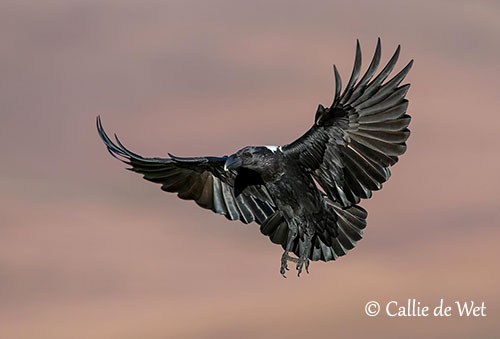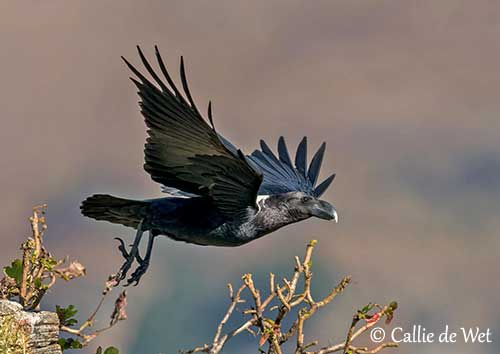
Fr: Corbeau à nuque blanche
Ang: White-necked Raven – White-naped Raven
All: Geierrabe
Esp: Cuervo Cuelliblanco
Ita: Corvo imperiale collobianco
Nd: Witnekraaf
Sd: vitnackad korp
Photographers:
John Anderson
John Anderson Photo Galleries
Tom Merigan
Tom Merigan’s Photo Galleries
Callie de Wet
GALLERY
Text by Nicole Bouglouan
Sources:
HANDBOOK OF THE BIRDS OF THE WORLD Vol 14 by Josep del Hoyo-Andrew Elliot-David Christie - Lynx Edicions – ISBN: 9788496553507
BIRDS OF AFRICA SOUTH OF THE SAHARA by Ian Sinclair and Peter Ryan - Princeton University Press Princeton and Oxford - ISBN: 0691118159
CROWS AND JAYS by Steve Madge – Ed. Christopher Helm – ISBN: 0713652071
CORBEAUX ET GEAIS: Guide des Corbeaux, Geais et Pies du Monde – Steve Madge, Hilary Burn – Editeur : Vigot (18/04/1996) – ISBN 10: 2711412687 – ISBN 13 : 978-2711412686
SORA - INDIVIDUAL VARIATION IN THE WHITE-NECKED RAVEN
Cykel Kurt - White-necked Raven
Wikipedia, the free encyclopaedia
White-necked Raven or White-naped Raven
Corvus albicollis
Passeriformes Order – Corvidae Family
INTRODUCTION:
The White-necked Raven is found in E and S Africa where it frequents hilly, rocky and mountainous regions. It hunts in the nearby plains and grasslands, and can be seen in open areas in cities and towns.
It feeds on various invertebrates and vertebrates including numerous insect species and lizards, snakes, small birds and small mammals. Like other Corvidae, it is a scavenger and takes carrion along roads.
The White-necked Raven is monogamous with long-term pair-bond. The pair breeds solitary and builds a large platform of twigs and sticks, lined with softer materials. The nest is often placed on cliff ledges and in crevices, rarely in trees.
The White-necked Raven is described as “locally common”. It is often considered a pest in some parts of the South African range, involving trapping and shooting by farmers. Some decline is reported in extreme N Kenya. But currently, the species is not globally threatened.

DESCRIPTION OF THE BIRD:
Biometrics:
Length: 50-56 cm
Wingspan: 75-86 cm
Weight: 762-865 g
The White-necked Raven is very similar to the Thick-billed Raven, and both species are sometimes placed in a separate genus “Corvultur”.
The plumage is very dark overall, with blackish-brown head, neck and underparts. There is a purplish sheen more or less visible depending on the light.
On the upperparts, a contrasting white patch on lower nape and upper mantle extends slightly onto the neck sides.
Foreneck and breast feathers are often edged whitish, almost forming a weak, pale breastband.
Rest of plumage, wings and tail are black with green sheen. The tail is relatively short, whereas the wings have broad base.
In worn plumage, the bird becomes dull brownish.
On the head, the rictal bristles are fan-shaped and upcurved, covering the basal third of the upper mandible. On the throat, the feathers are pointed and slightly forked.
The bill is massive with strongly arched culmen. It is black with whitish tip. The eyes are dark brown. Legs and feet are black.
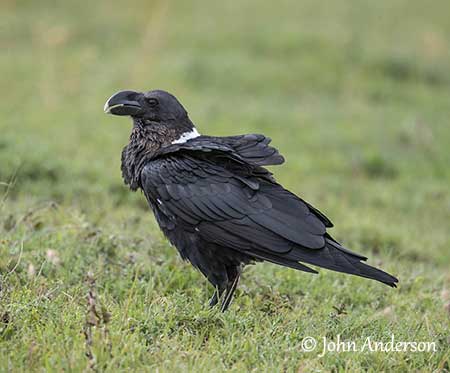
Male and female are similar.
The juvenile is duller than adults. There are sometimes some dark streaks on the white nape patch, and scattered white feathers on neck and breast.
The bill is entirely black and the white tip is absent.
RANGE:
The White-necked Raven is found in a band from Kenya and Tanzania, through Malawi to Southern Africa. It is restricted to areas of Zimbabwe, Lesotho, Swaziland, Western and Eastern Capes, Kwazulu-Natal and Limpopo Province.
HABITAT:
The White-necked Raven frequents open hilly and mountainous areas. It can be seen flying and patrolling over adjacent plains and grasslands, gorges, rugged hills and open hill forest.
This species occurs mainly between 1,000 and 3,000 metres of elevation, although in South Africa, it occurs at sea-level. In Tanzania, it may be found up to 5,000 metres.
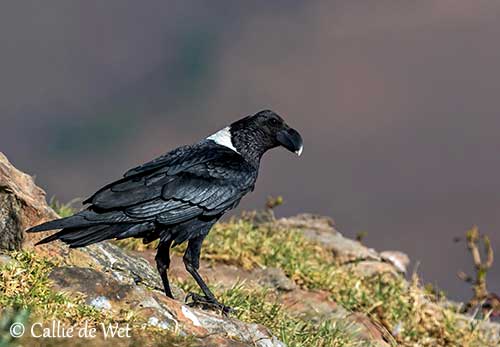
CALLS AND SONGS: SOUNDS BY XENO-CANTO
The White-necked Raven’s calls are very similar to those of the Common Raven, but with a more raucous tone.
It typically gives a high-pitched, slightly quavering, short, rolled “kraa” or a longer “krrraaa”. We can also hear a short, metallic “cluk-cluk-cluk” uttered while bowing the head towards its mate.
Vocal mimicry is recorded, but only in captivity.
BEHAVIOUR IN THE WILD:
The White-necked Raven is omnivorous, although it appears mainly carnivorous. It feeds on a variety of insects, birds, mammals, reptiles, fruits and other plant material. It also scavenges on road kills and steals eggs from other bird nests.
Several observations describe the bird carrying small tortoises in flight, and dropping them onto rocks to break the shell and then eating the juicy flesh. This behaviour is reminiscent of that of the Bearded Vulture.
The White-necked Raven patrols the roads while searching for road kills. It takes frogs and dead fish on lake shores. It scavenges at rubbish dumps. It also eats some plant material including maize, peanuts, fruits and berries.

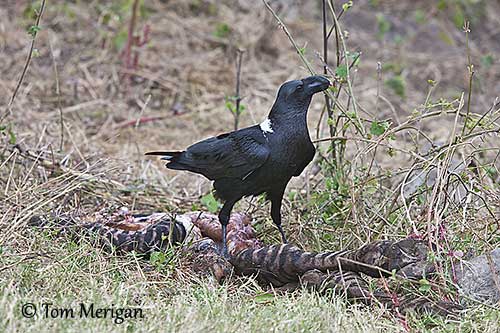
It forages alone or in pairs, searching for food items primarily on the ground. It walks with swaggering gait and upright stance, or by hopping with agility. It also takes insects from foliage inside the tree canopy.
Large flocks of up to 150 individuals are sometimes reported, probably attracted by abundant food resources. These flocks are mainly gathering of non-breeder birds outside of breeding season. They are often in the company of raptors, mainly kites and vultures.
The White-necked Raven is monogamous with long-term pair-bond. The pairs are territorial.
Courtship feeding by male to female is part of the courtship displays. The female begs by vibrating both wings and tail while giving chirring calls, similar to the begging calls of the juveniles. The male places the food into the female’s mouth.
Later, the male will provide food to the female on the nest.
They build a large stick nest on cliff ledge or in crevice, rarely in tree.
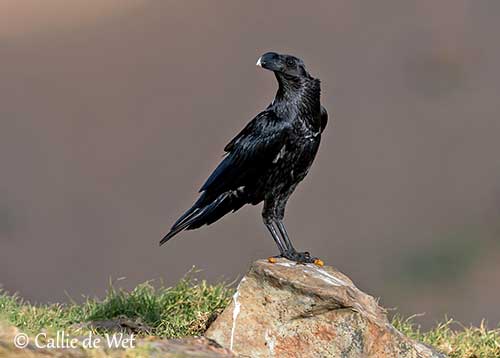
The White-necked Raven is mainly sedentary, although non-breeders are semi-nomadic and wander widely outside of breeding season.
They roost communally on cliffs, in groups of up to 40 individuals.
The flight is agile and powerful. The White-necked Raven may spend a lot of time in thermals, high in the air, often with vultures. It can be seen swooping and diving over cliff faces, playing with sticks and stones, dropping them and catching them again, while the wind may produce loud whining sound through the primaries. This species soars well, but with shallower wingbeats than other Corvidae.
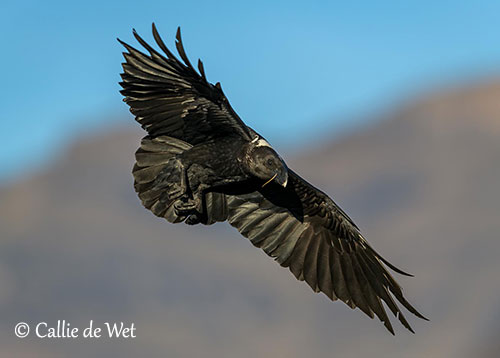
REPRODUCTION OF THIS SPECIES:
The laying varies depending on the range, from October/December in Kenya, to August/December in South Africa.
The White-necked Raven breeds solitary. They are monogamous with long-term pair-bond.
The nest is usually built on inaccessible ledge or hole in cliff, rarely in tree. It is a large, cup-shaped structure made of sticks and twigs. The deep cup is lined with softer materials such as wool, fur, grass and feathers. It is usually placed about 30 metres from the ground.
The female lays 2-7 eggs, but usually 4 pale green, bluish-green or whitish eggs with olive, brown and grey markings. She incubates probably alone during 19-21 days, but she is regularly fed on the nest by her mate.
The chicks are fed by regurgitation by the female. The male rarely helps but it is usually present around the nest-site.
The young remain at nest during 3-4 weeks. They are in family group during a few weeks before the next breeding season.
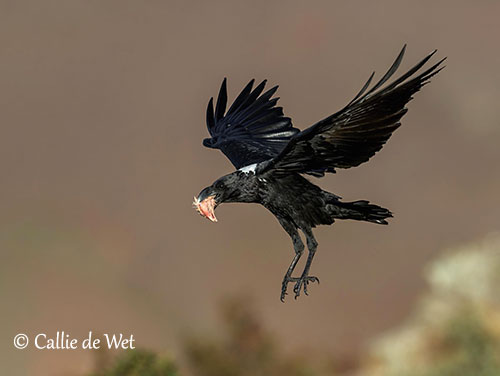
Most Corvidae species start to incubate the eggs before the clutch is complete, and the eggs hatch asynchronously.
The first eggs are larger, involving larger chicks too. The adults give most attention to the larger, more vigorous chicks. If the food resources are limited, the smaller chicks starve to death.
In the southern part of the range, on average, two young per nest fledge.
PROTECTION / THREATS / STATUS:
The White-necked Raven is generally uncommon to locally common.
This raven is heavily trapped, poisoned or shot by farmers, and its nests can be destroyed as this species is considered a pest in parts of South Africa.
Poisoned carcasses for predators of cattle and sheep are also eaten by the White-necked Raven, involving a decrease of the population, especially in N Kenya.
The size of the population is unknown, but the species is not considered globally threatened.
The White-necked Raven is currently evaluated as Least Concern.
